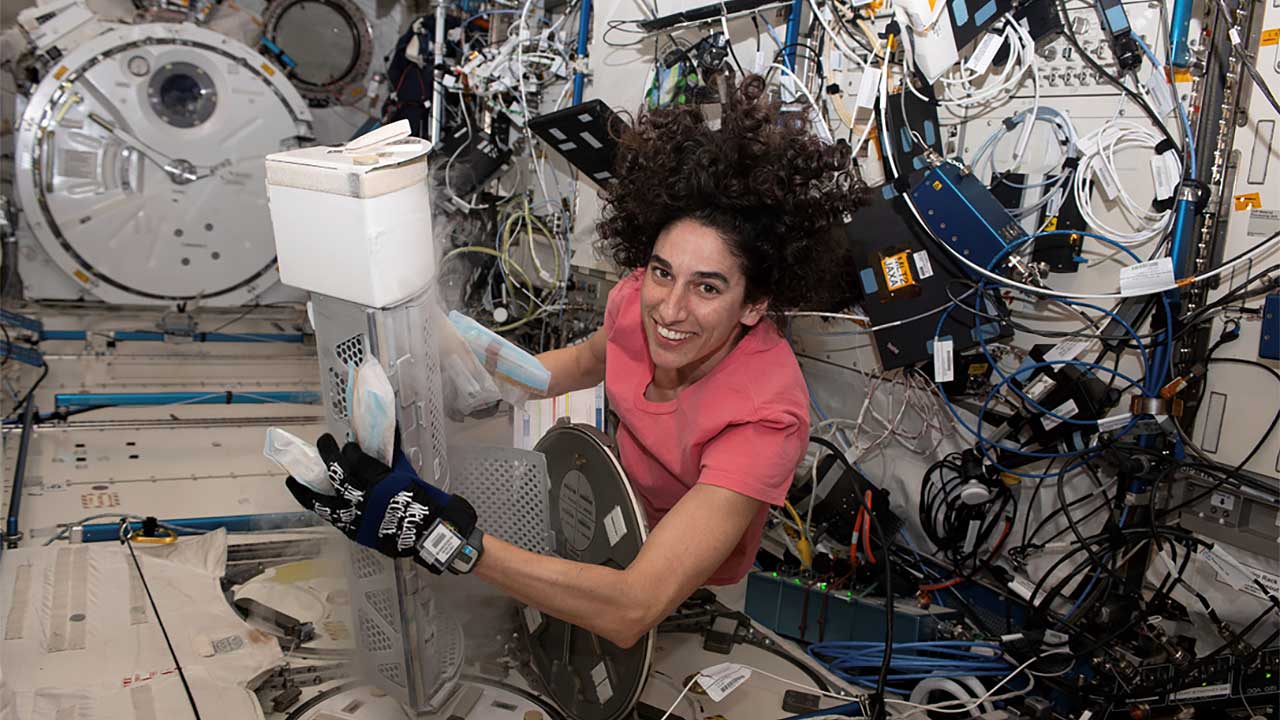Studying Cardiac Cells in Space to Repair Heart Damage on Earth

Flight Engineer Jasmin Moghbeli works onboard the ISS in March 2024 to retrieve bags containing heart cells for the Emory team's experiment.
Media Credit: NASA
ISS National Lab-sponsored research is accelerating the development of regenerative therapies that could one day reverse heart damage—learn more in the latest issue of Upward magazine
March 28, 2025
KENNEDY SPACE CENTER (FL), March 28, 2025 – Heart disease remains the leading cause of death in the United States, accounting for one in five deaths. The inability of damaged heart muscle tissue to regenerate makes heart disease difficult to treat, and end-stage heart failure patients have no choice but to join a long list of people waiting for a heart transplant. Researchers from Emory University are working to provide another option for such patients. To do this, the team took their research to a laboratory unlike any on Earth—the International Space Station (ISSInternational Space Station).
Chunhui Xu and her team leveraged the ISS National Laboratory® for cardiac cell research to accelerate the development of cell-based regenerative therapies that could one day reverse heart damage. Results from these studies have led to multiple peer-reviewed publications, including findings recently published in the high-impact journal Biomaterials. Follow along on Xu’s journey to space-based research in a story featured in the latest issue of Upward, official magazine of the ISS National Lab.
It all began with an eye-opening seminar on science in space and a surprising observation about cancer cells during spaceflight. Researchers found that exposure to microgravityThe condition of perceived weightlessness created when an object is in free fall, for example when an object is in orbital motion. Microgravity alters many observable phenomena within the physical and life sciences, allowing scientists to study things in ways not possible on Earth. The International Space Station provides access to a persistent microgravity environment. increased cancer cell proliferation and survival. Xu hypothesized that heart cells might exhibit similar behavior, which would address two current roadblocks in developing cell-based therapies for heart disease.
After successfully testing the theory in a ground-based study using simulated microgravity, Xu and her team conducted two spaceflight investigations. The first examined how stem cells differentiate into heart muscle cells, while the second looked at the maturation of heart muscle cells into tissue-like structures. Insight gained from the team’s space-based research could significantly advance methods to produce cardiac cells for regenerative therapies, helping to transform the landscape of heart disease treatment.
In the article, Xu says, “The space environment provides an amazing opportunity for us to study cells in new ways. Our research on the ISS could allow us to develop a new strategy to generate cardiac cells more efficiently with improved survival when transplanted into damaged heart tissue, which would greatly benefit patients on Earth.”
Read more about the team’s exciting research in the Upward feature, “Celestial Cells.”
Download a high-resolution image for this release: NASA Astronaut Jasmine Moghbeli
Media Contact:
Patrick O’Neill
904-806-0035
PONeill@ISSNationalLab.org
# # #
About the International Space Station (ISS) National Laboratory: The International Space Station (ISS) is a one-of-a-kind laboratory that enables research and technology development not possible on Earth. As a public service enterprise, the ISS National Laboratory® allows researchers to leverage this multiuser facility to improve quality of life on Earth, mature space-based business models, advance science literacy in the future workforce, and expand a sustainable and scalable market in low Earth orbit(Abbreviation: LEO) The orbit around the Earth that extends up to an altitude of 2,000 km (1,200 miles) from Earth’s surface. The International Space Station’s orbit is in LEO, at an altitude of approximately 250 miles.. Through this orbiting national laboratory, research resources on the ISS are available to support non-NASA science, technology, and education initiatives from U.S. government agencies, academic institutions, and the private sector. The Center for the Advancement of Science in Space™ (CASIS™(Abbreviation: CASIS™) The nonprofit organization that manages the ISS National Lab, which receives at least 50 percent of the U.S. research allocation on the International Space Station to facilitate research that benefits humanity (NASA manages the other 50% and focuses on research for space exploration purposes).) manages the ISS National Lab, under Cooperative AgreementA cooperative agreement is Federal assistance that establishes a relationship between the U.S. Government and a recipient in which the principal purpose of the relationship is to accomplish a public purpose of support or stimulation. Since 2011, the Center for the Advancement of Science in Space™ (CASIS™) has managed the National Laboratory® through a Cooperative Agreement with NASA. with NASANational Aeronautics and Space Administration, facilitating access to its permanent microgravity research environment, a powerful vantage point in low Earth orbit, and the extreme and varied conditions of space. To learn more about the ISS National Lab, visit our website.
As a 501(c)(3) nonprofit organization, CASIS accepts corporate and individual donations to help advance science in space for the benefit of humanity. For more information, visit our donations page.